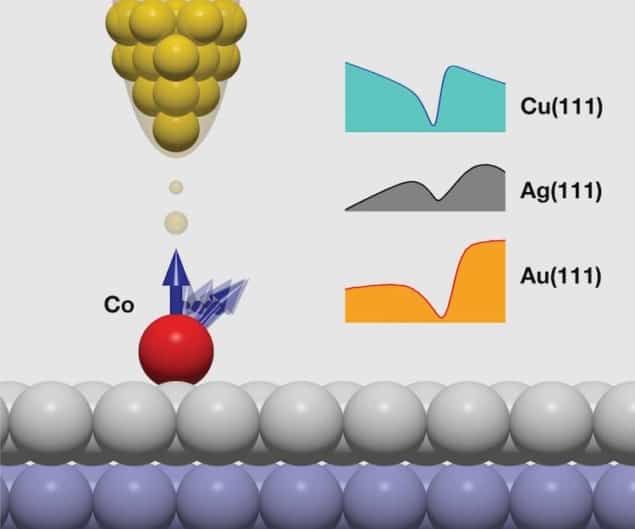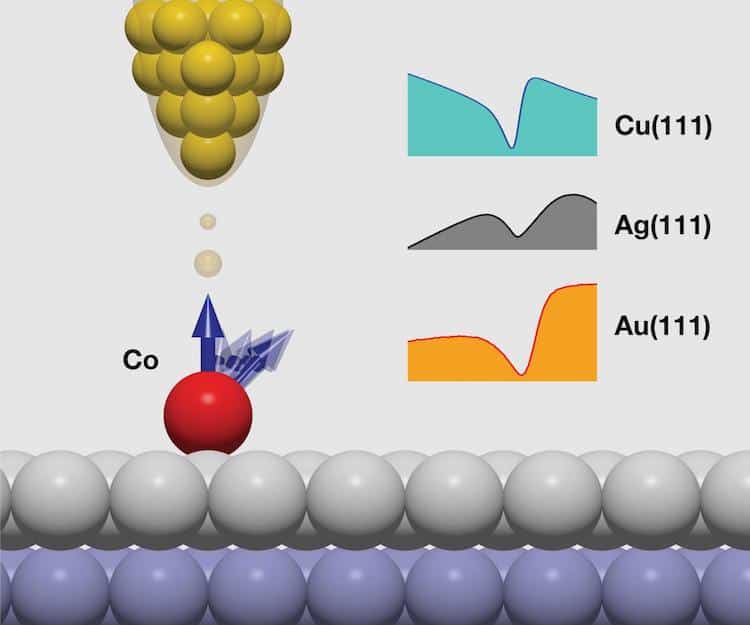
A new type of quasiparticle – dubbed the “spinaron” by the scientists who discovered it – could be responsible for a magnetic phenomenon that is usually attributed to the Kondo effect. The research, which was carried out by Samir Lounis and colleagues at Germany’s Forschungszentrum Jülich, casts doubt on current theories of the Kondo effect, and could have implications for data storage and processing based on structures such as quantum dots.
The electrical resistance of most metals decreases as the temperature drops. Metals containing magnetic impurities, however, behave differently. Below a certain threshold temperature, their electrical resistance increases rapidly, and continues to increase as the temperature drops further. First spotted in the 1930s, this phenomenon became known as the Kondo effect after the Japanese theoretical physicist Jun Kondo published an explanation for it in 1964.
Kondo showed that the spin of a magnetic impurity, which comes from its magnetic moment, strongly couples, or “sticks”, to the spins of all the electrons in the region surrounding it. The resulting “cloud” of spin-coupled electrons effectively screens off the conducting electrons and prevents them from moving, producing the observed increase in the metal’s resistance.
Kondo resonances
One key signature of the Kondo effect is the dips, or resonances, in the electron transport spectra observed when magnetic impurities are deposited on metal surfaces. These resonances can be detected by scanning tunnelling spectroscopy (STS), a technique that makes it possible to position and detect individual atoms on a surface and record energy spectra at exactly these positions.
Researchers measured such resonances for the first time in 1998, observing a dip in the measurement curve at the point where magnetic cobalt atoms were deposited on a gold surface. Before this pioneering series of experiments, the Kondo effect could only be detected indirectly, through resistance measurements. These first STS results – which were later confirmed for cobalt atoms on the surface of other metals, such as copper and silver – therefore opened up a new way of studying many-body physics at the sub-nanoscale.
Inelastic spin-excitations are important
The Jülich team, however, argues that this characteristic dip is not, in fact, an unambiguous sign of the Kondo effect. Instead, their studies suggest that another phenomenon altogether – magnetic anisotropy – is creating the dip.
In a paper published in Nature Communications, the researchers explain that, below a specific temperature, the magnetic moment of the cobalt impurity atom couples to the crystal lattice of the atoms in the gold surface. At this point, its moment essentially “freezes”. Meanwhile, above the critical temperature, certain excitations of the magnetic moment, known as inelastic spin-excitations, arise thanks to the spin properties of the tunnelling electrons used in STS.

Kondo effect induces giant negative thermal expansion
Based on a recently developed mathematical model that combines relativistic time-dependent density functional theory (TD-DFT) and many-body perturbation theory (MBPT), Lounis and colleagues think the dip in the measurement curve could stem from interactions between the inelastic spin-excitations and electrons. These interactions form a bound “spinaron” state and the physics of the overall system is dictated by the relativistic effects induced by these interactions. The combination of spin-excitations and spinaron give rise to transport curves that agree rather well with the ones supposedly arising from the Kondo effect, the researchers say.
“Much of what we thought we had learned about the Kondo effect over the last two decades, and which has already found its way into textbooks, needs to be re-examined,” Lounis says. “For our part, we are now planning to systematically investigate various nanostructures believed to host Kondo resonances,” he tells Physics World. “We also hope to unravel the complexity and richness of the physics behind the spinaron and explore news ways of identifying the interplay between spin-excitations, spinarons and Kondo features.”
